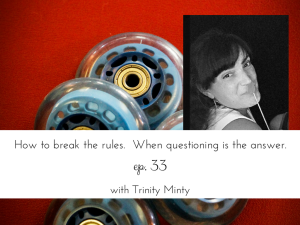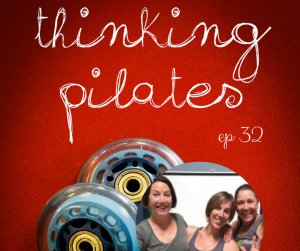By Skillful Teaching Mentor, Trinity Minty
Pilates teachers very well may be some of the most focused and driven people I know. Most of us are passionate about what we do and are gluttons for continuing education. A great many of us hold certificates in a wide variety of modalities, whether they are the foundations from which we came to Pilates or the building blocks we have used to develop our craft.
New information, research, and approaches are made available to us as quickly as we can sign up for the courses. And, sign up we do!
Being the motivated and inspired bunch that we are, we can’t wait to get back to the studio and share with our students all the exciting new information that we’ve learned, which brings me to the topic of this article.
How do we effectively integrate new information and why is this question even important?
What is your current approach to integrating new information? How do you harness all of the excitement and flood of information into something digestible?
For most of us, instead of being discerning about what and how much should be added, we allow ourselves to be swept up in the moment and leap in head first. Our excitement can come through in a way that leaves our students wondering who we are and what happened to the teacher we were last week.
Learning how to integrate and disseminate new information can come long before the actual information as a proactive approach. One way I set the stage for this is by consistently asking for feedback from my students. I don’t mean, “Hey, how’s my teaching?” I mean asking them how things feel, what does their body have to say about any particular movement or adjustment? What adjustments can they make in order to find more balance, ease, connectedness, range of motion, etc? Of course, when we ask questions, it’s always beneficial to know that your students may not immediately have an answer, if at all. Totally okay!
This means creating and holding space for your students to understand that there is no “wrong.” This space is essential to inspiring your students’ confidence within themselves and building a trusting relationship with you. When we teach our students to work from exactly where they are, we afford ourselves the freedom to teach from exactly where we are.
The value in teaching this way is that our students become accustomed to and comfortable with being a part of the process; it allows them to take ownership in the learning. Because of this, when we have new information to share, our students are already primed for the experience.
Another way to take proactive steps toward integrating new information is to always explain the “why” of what you’re asking your students to do. When it comes time to add new or different concepts, you can rely on the “why.”
So what is the “why” of teaching and how is it different than the “what?” This can be looked at from both the macro and micro view. The macro view: What method do we teach? The Pilates Method (and maybe more). The Micro view: In any given day, we teach many classes and/or sessions. Within those classes and sessions we teach many exercises in a variety of orders, to a variety of bodies. That is the “what.” The “why” is what drives the “what.” The macro view: Why do we teach Pilates? Why have we chosen that tool over others? Why do we teach a certain amount of hours in a day? Why do we teach at this place versus that place? The micro view: Why do we teach specific exercises in a particular order? Why do we choose to begin sessions a certain way? Why do we say “client” versus “student”? Why do we show up day after day? The “what” is the hammer and nail. The “why” is what motivates us to pick it up. Students are attracted by the “what”, but stay because of the “why.”
Becoming connected to our “why” is invaluable to offering our students the foundation from which they can discover their own “why,” and invaluable to creating an open and safe learning environment from day one.
When the time comes to experiment with a new idea or approach I like to preface the shift in direction explicitly. “We had been setting up for spinal extension, flexion, rotation, whatever it may be, like this, now I’d like to do it with, add new approach or focus here.” Then, ask questions! How did the quality change? Was the experience different?
Why is integrating new information and doing it well so important?
What we work out on the mat, we work out in our lives. By integrating new information we are putting ourselves in the flow and not resisting it. It offers us the opportunity to inspire and be inspired. It offers us a space to let go of things that no longer serve us and quite possibly impede our progress and potential.
Now, it’s time to look at this in a super clear, tangible way. Because so many of our cues and approaches are passed down without question they end up leading to poor movement and lack of progress. The most recent awakening I’ve had is around scapular placement in spinal flexion. Let’s use coming into the 100’s position as a platform. We hear and most likely use cues like, curl up, reaching the arms long or toward the heels, keeping the collarbones wide. Great, yes, this is what we want. But do we always want this? Do we want this at any expense, no matter what? Or do we maybe want something a little different, but don’t know how to ask for it? I find that cueing, and possible over-cueing, the arms down and collarbones wide in spinal flexion may get us where we think we want to go, but not necessarily to a place of greatest efficiency or where we are truly tapping into the “why” of the exercise. What is the why of the 100 anyway? I certainly have my thoughts around it, and would love to know yours, for the sake of great conversation and collaboration.
If part of what we’re looking for is solid, supported spinal flexion, we may have to let go, just a bit, of the “shoulder blades down, collarbones wide” focus. In my experience, I need some serratus to come into play with the purpose of not so much pulling the scapula forward, but drawing the ribs back, without necessarily allowing the pecs to take over creating a closing of the chest. We are looking for a sweet spot here. This may mean that the collarbones are not quite as wide as you think they should be. I think that’s okay! Especially if you are seeing or experiencing a truly sweet abdominal curl.
This is not to say that the approach I’ve described here is the right way and that you should immediately adopt this approach, nor should you completely dismiss it. However, play with it, check it out in your own body, see what it looks like and what kind of feedback you get from your students. Then decide to keep it, tweak it, make it your own or just throw it away.
This is how good discernment happens.
Take some time to think of one way to assess whether or not you are in fact integrating new information. Does it come easily to you or do you find yourself resisting? If you find that you are meeting with resistance, choose one way that you can begin to shift. I would love to hear your thoughts and experiences with this.
Because a critical part of teaching is learning, I’d like to give credit where credit is due. I continue to have the absolute pleasure of working with some incredibly talented and thoughtful teachers. Chantill Lopez, who is my partner in crime, ok, maybe I am hers, has always offered clear, constructive feedback that both challenges my thinking and offers affirmation to my approach. She has consistently and generously shared her knowledge and experience with me and offers an incredible platform for me to learn and grow as a teacher. Debra Kolwey, who in a single session last summer, possibly unknowingly, offered the seed from which this article grew. The tremendous James Crader, who, through both his movement teaching and dialogue, offered just the sustenance needed to inspire me to reconnect with this topic . Last but certainly not least, Tina Woelbling, who was the first teacher I ever worked with. She offered a safe space for me to bring my sometimes tired and often neglected body and spirit to move in a way that felt good. Fantastic even.



 How are you showing up? Why are you showing up? Why do you teach? What IS teaching? Why do you care? This is Skillful Teaching: A Whole-person approach to being an expert teacher, not an expert technician. There's a difference. Want to know what it is?
How are you showing up? Why are you showing up? Why do you teach? What IS teaching? Why do you care? This is Skillful Teaching: A Whole-person approach to being an expert teacher, not an expert technician. There's a difference. Want to know what it is?